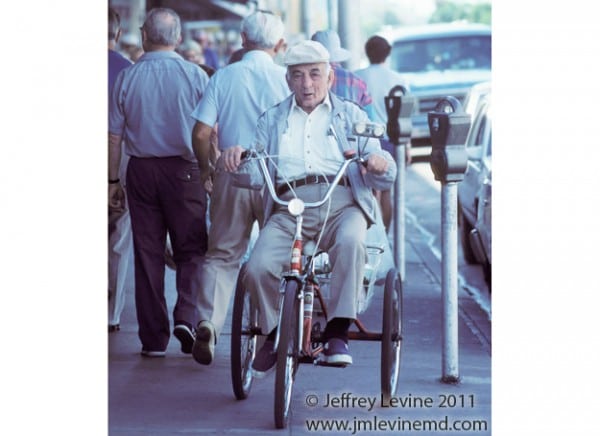
When I was growing up, my grandparents wintered in Miami. I remember visiting them and feeling the warm sunshine and sand that sometimes scalded your feet when days were hot. In 1985 while training in geriatrics in New York City, I returned to Miami to photograph the aging Jewish retirees. Little did I know that I was recording the twilight of Jewish South Beach.
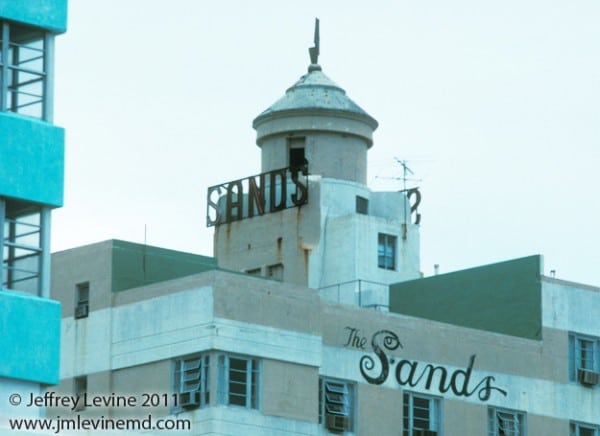
These Kodachromes were in storage for over 25 years when I found them in a box. I scanned them into Photoshop where I dedusted them and before my eyes a vanished world emerged.
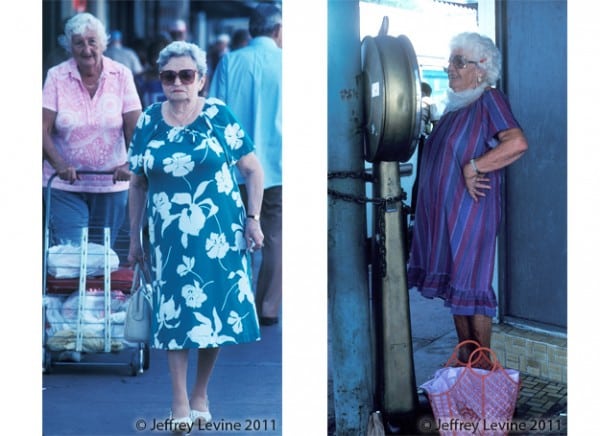
In these photos you can see a run-down Ocean Drive beachfront partially surrounded by barbed wire. The neon decorated hotels with names like Shorecrest, Haddon Hall, and Royal Palm all had elderly people passing the time in chairs on the porch. The smells of mildew and chicken soup drifted from the open doors. Other hotels like the Ritz Plaza and The Sands were dilapidated and fading, and the skyline did not have the high-rise look of today’s Miami Beach. Washington and Collins Avenue had no boutiques, and were crowded with older people shopping for vegetables and speaking Yiddish.
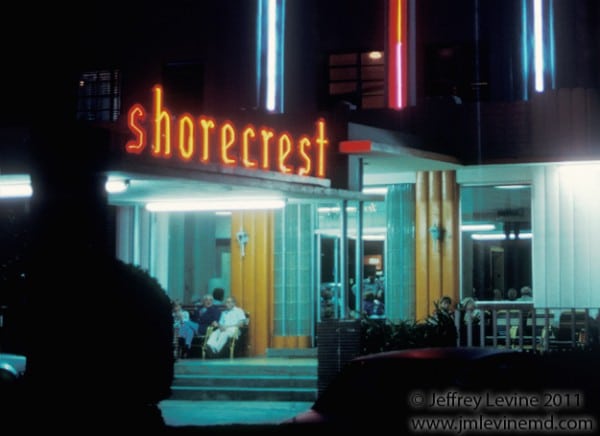
In 1913 the first Jewish people settled in Miami Beach. A tourist and real estate boom took place in the 1920’s, but barriers to Jewish ownership of real estate restricted them to south of Fifth Street – the area that became known as South Beach. The population grew to 3,500 Jews, and in 1949 Florida’s Legislature ended discrimination in real estate and hotels.
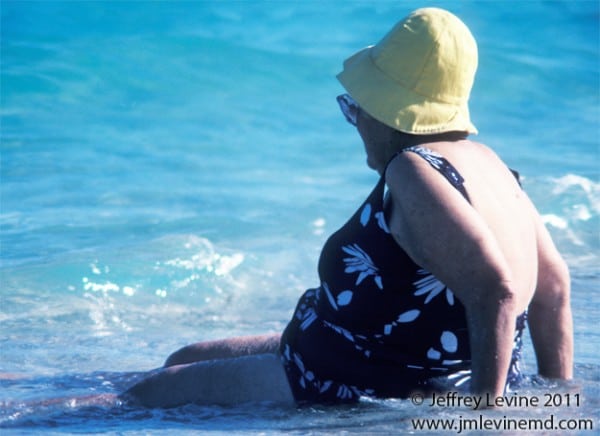
South Beach became the place to go for Jewish winter vacations and retirement, a place that would be called a NORC today, standing for Naturally-Occurring-Retirement-Community. Isaac Bashevis Singer, the Nobel Prize winning author who wrote in Yiddish, made his winter home there. He wrote,
“For me, a vacation in Miami Beach was a chance to be among my own people. In those days Miami Beach was a magnet for Jewish people – a place where they flocked like geese to rest and warm themselves in the sun.”
The Art Deco buildings of the 1930s and 1940s – many designed, built and operated by Jews during the days of restricted ownership – ultimately became world recognized architectural treasures. In the 1980s, Barbara Baer Capitman launched the campaign that established the Art Deco District, which began the transformation of South Beach into an upscale scene of models, clubs, and luxury hotels.
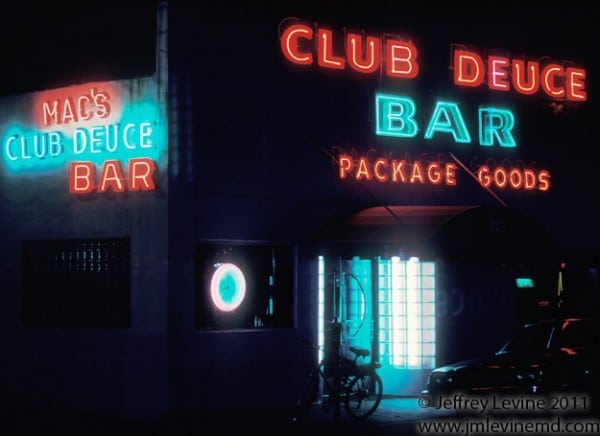
According to statistics from the Greater Miami Jewish Federation, in the 1970s, about 80 percent of the population on Miami Beach was Jewish. By 1980, the Greater Miami Jewish population reached its all-time peak of 230,000. By 1985, the Jewish population had declined to 209,000. This was the year that I visited with my camera.
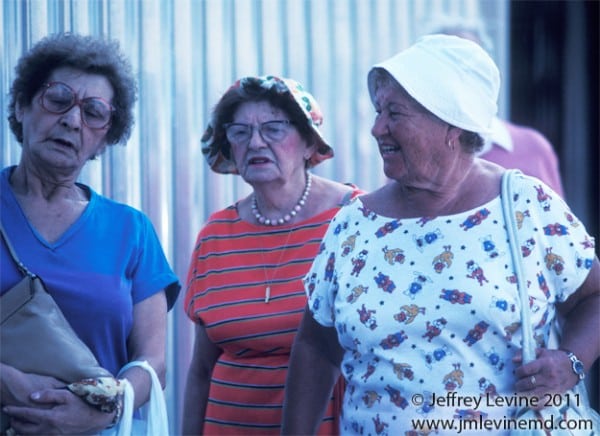
Today many landmarks have disappeared such as Wolfies, the last standing Jewish deli in Miami. The last kosher hotel, the Saxony, closed in 2005 to make way for condominiums. While the elderly Jews have vanished, the pastel colored Art Deco hotels still stand. But I am certain that there are still plenty of memories of grandparents walking the streets and strolling in the cool waves that washed the shores of South Beach.
* * * * * * * * * * * * * * *
Related posts:
A Train Graveyard in Thorndike Maine
Aging on the Covers of The Gerontologist
Celebrating Old Age at the Burning Ghats of Benares
Victory Day in Moscow
A Taste of Ancient Peruvian Medicine
The Twilignt of Jewish South Beach, Miami
The Elders of Taquile Island in Peru
Aging in Central Asia
Photographing Los Ancianos of Bolivia
Aging Inside Angola State Penitentiary
Faces of Istanbul
Photographing Wigstock in Tompkins Square Park 2003
Geriatrics, Art, and Ancient Treasure on Lake Titicaca
An Abandoned Psychiatric Hospital in Tuscany
Childhood Dreams Under the Pulaski Skyway
Manhattan After the Hurricane
Photographing Letchworth Village
Returning to Cow Canyon Trading Post
More Vanished Signs of New York
The Meatpacking District Before the High Line
.

My family owned the Haddon Hall Hotel at 1500 Collins Ave from 1945- 1963.
I lived in Surfside and attended Bay Harbour Elmentary and Nautilus Jr. High before moving to Monticello N.Y.
Jeff–
I loved seeing these…
When I was 10–1958–I visited my grandparents who spent about 3-4 months a year in a rented apartment at Lincoln Road and Collins Ave. I spent almost a month with them at the time. I was free to roam the neighborhood, go in the shops, buy ice cream. I took the public bus as far up the beach as they went in those days–there were miles of undeveloped beach up to the Fountainbleau hotel which was under construction at the time.
I remember Wolfie’s and another place that had baskets of the most delicious rolls and baked goods they would put out on the table for you–The Rascal House, I think it was called. They encouraged you to take home the ones you did not eat.
I bought one of the earliest issues of MAD magazine at the corner newsstand and still remember how excited I was as I read the funny, satiric, snarky pieces.
Most of all I remember the people, all like my grandparents, who had come to America seeking “the land of milk and honey,” escaping oppression, discrimination, pogroms or worse. They wanted the opportunity to give their children more than they had, that they ever could have hoped for in the shtetls of Poland, and Russia and other eastern European countries. Had they waited any longer to leave their homes, their villages, their families–well, they would have been rounded up by the Nazis and their ilk–and I would not be writing this…
What they found in America, what my grandparents found, was not milk and honey. But they did find opportunity, a spark, a chance. For my grandparents–Sam and Bessie Pollack–it was sweatshop work on the lower east side of NY until they could save enough money to buy a tiny confectionery store on the corner of Baltimore and Pearl Streets in the city of my eventual birth, Baltimore. My grandparents slaved seven days a week, turning that store into a haven for jewish businessmen to come in for a delicious home-cooked lunch on workdays. On weekends they would bring their families back for dinner as the reputation of my grandmother’s cuisine spread.
My mother and her sister worked as waitresses in the restaurant, eventually met their husbands there.
When my grandparents retired they gave themselves the gift of these few months in Miami Beach each winter. They lived frugally, never went out for a meal. But they felt–and I could see it even as a 10 year old looking into their lined faces–rejuvenated in some way: the sun, the blue blue sky, the wide beach, the turquoise waters of the sea. There amongst their fellow immigrant jews, they found the land of milk and honey. At least for a little while before they died–too young, it seems to me looking back. They deserved many more winters in Miami Beach.
I will never forgot that one winter I shared with them there. I have gone back but it is not–and never will be–the same.
Best,
Jerry
Jerry I love this. Your wonderful remembrances made my day. Thank you for your beautiful family memories you have shared. You are an extremely blessed man. I know your comments are thirteen years old but I’m just now reading and learning this history. Again thank you so much